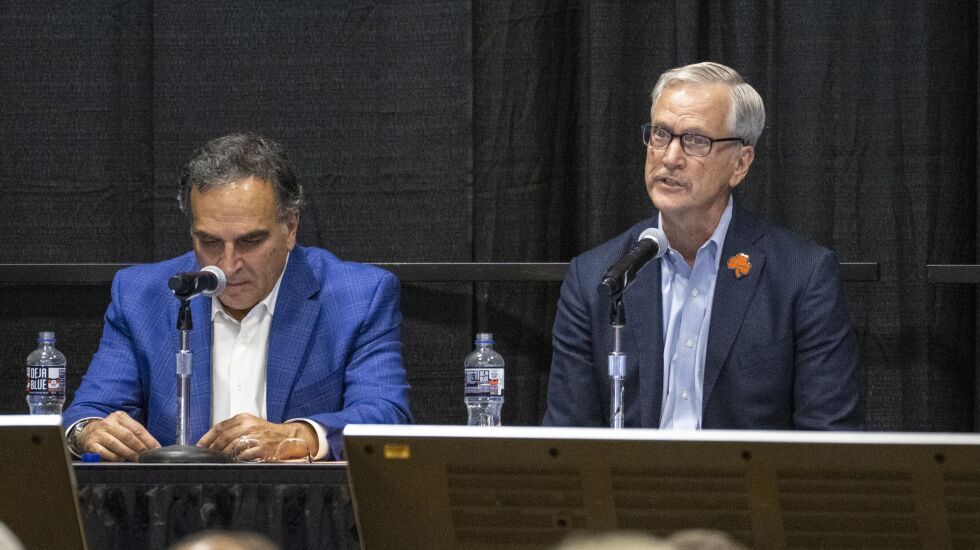
The Bears are saying “if” as often as possible when it comes to building a stadium in Arlington Heights, but it’s clear they’re proceeding like it’s a certainty.
“We don’t have a Plan B,” team president Ted Phillips said during a town hall at Hersey High School on Thursday. “Our singular focus is on this property.”
Chairman George McCaskey prefaced everything with “if” when he opened the meeting, but the overall tone of the presentation was that the Bears are pushing with full force to leave Soldier Field, the NFL’s oldest and smallest stadium.
He imagined securing “a world-class home for the Chicago Bears after a more-than-100-year search,” started by George Halas, his grandfather.
“We will not be discussing any other alternative sites, including renovations of Soldier Field,” Phillips said, drawing applause from the half-full gymnasium.
He went on to get cheers from the crowd when he said the stadium will be “enclosed” — he later specified the roof probably will be fixed, not retractable — and become a destination for major events such as the Super Bowl and concerts. He also said there will be significant increases in capacity and parking over Soldier Field’s 61,500 seats and limited spaces.
“It will be designed to provide our fans with the first-class experience they deserve,” Phillips said. Then he mused, “I’ve never had so many claps in my life.”
It’s difficult to imagine such a jarring transformation of Arlington Heights, where the 326-acre proposed stadium site is just down the block from Wayne’s Pizza and a cat clinic.
In some ways, the high school gym was an ideal setting for the Bears’ aw-shucks approach.
“My family and I are not real-estate developers,” McCaskey said. “We are privileged to own a beloved football team that is a community asset. ... We do recognize a once-in-a-lifetime opportunity.”
And he surely recognizes how ill-suited his team’s current home is.
When the Bears open the season Sunday against the 49ers, it’ll be clear to anyone there or watching on TV that Soldier Field falls far short of the modern standard for an NFL stadium — even with its newly installed Tahoma 31 Bermuda grass.
It stands as another sign that the Bears haven’t cleared the cobwebs of their past and stepped into the new millennium. The playing field usually looks like a driving range, there are cracks in the exterior and it’s missing the amenities and luxurious concourses of football palaces that have opened or been overhauled in the last decade.
The Bears and the city already tried renovations, spending $632 million in 2002 to make it look like a spaceship landed on the iconic pillars.
Phillips said the Bears will honor their lease, which runs through 2033. That does not, however, preclude them from buying out the agreement and leaving early. It’ll still take awhile, as the organization is working toward closing on the property purchase by early 2023.
Meanwhile, McCaskey has seen firsthand what an NFL stadium should look like. The Bears played at sparkling SoFi Stadium in Los Angeles in 2020 and ’21 and visited Allegiant Stadium in Las Vegas last season.
Those are the NFL’s newest gems, and the Bears would be highly unlikely to go anywhere near SoFi’s $5.5 billion price tag, but they don’t have to match the latest and greatest to build something impressive. The Vikings’ U.S. Bank Stadium, for example, opened in 2016 at $1.1 billion. Phillips called the total development a $5 billion project, but that includes a lot more than the stadium.
Strictly from the standpoint of having an NFL-worthy stadium, it’s time for the Bears to start fresh with a blank canvas.







